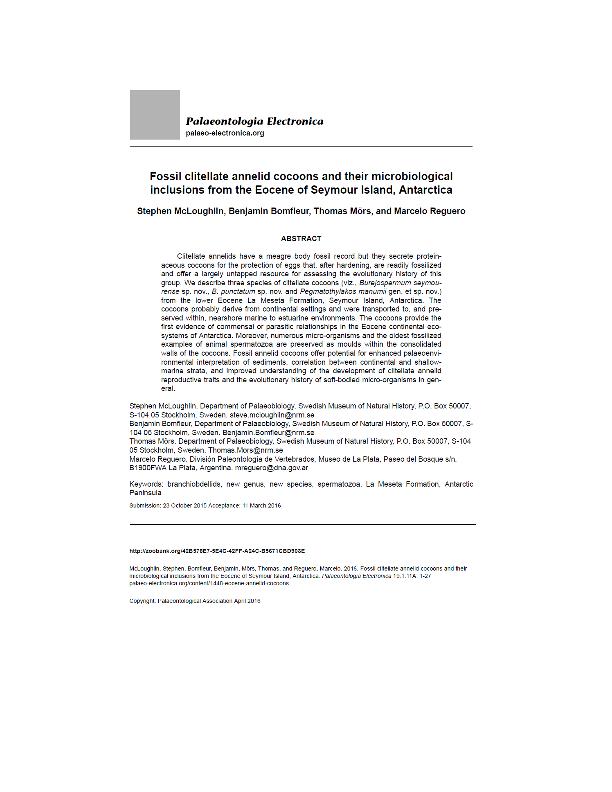Mostrar el registro sencillo del ítem
dc.contributor.author
Mc Loughlin, S
dc.contributor.author
Bomfleur, B
dc.contributor.author
Mörs, T
dc.contributor.author
Reguero, Marcelo Alfredo

dc.date.available
2018-08-24T20:17:08Z
dc.date.issued
2016-03
dc.identifier.citation
Mc Loughlin, S; Bomfleur, B; Mörs, T; Reguero, Marcelo Alfredo; Fossil clitellate annelid cocoons and their microbiological inclusions from the Eocene of Seymour Island, Antarctica; Coquina Press; Palaeontologia Electronica; 19; 11; 3-2016; 1-27
dc.identifier.issn
1532-3056
dc.identifier.uri
http://hdl.handle.net/11336/57082
dc.description.abstract
Clitellate annelids have a meagre body fossil record but they secrete proteinaceous cocoons for the protection of eggs that, after hardening, are readily fossilized and offer a largely untapped resource for assessing the evolutionary history of this group. We describe three species of clitellate cocoons (viz., Burejospermum seymourense sp. nov., B. punctatum sp. nov. and Pegmatothylakos manumii gen. et sp. nov.) from the lower Eocene La Meseta Formation, Seymour Island, Antarctica. The cocoons probably derive from continental settings and were transported to, and preserved within, nearshore marine to estuarine environments. The cocoons provide the first evidence of commensal or parasitic relationships in the Eocene continental ecosystemsof Antarctica. Moreover, numerous micro-organisms and the oldest fossilizedexamples of animal spermatozoa are preserved as moulds within the consolidatedwalls of the cocoons. Fossil annelid cocoons offer potential for enhanced palaeoenvironmental interpretation of sediments, correlation between continental and shallowmarine strata, and improved understanding of the development of clitellate annelid reproductive traits and the evolutionary history of soft-bodied micro-organisms in general.
dc.format
application/pdf
dc.language.iso
eng
dc.publisher
Coquina Press

dc.rights
info:eu-repo/semantics/openAccess
dc.rights.uri
https://creativecommons.org/licenses/by-nc-sa/2.5/ar/
dc.subject
Branchiobdellids
dc.subject
Spermatozoa
dc.subject
Eocene
dc.subject
Antarctic Peninsula
dc.subject.classification
Meteorología y Ciencias Atmosféricas

dc.subject.classification
Ciencias de la Tierra y relacionadas con el Medio Ambiente

dc.subject.classification
CIENCIAS NATURALES Y EXACTAS

dc.title
Fossil clitellate annelid cocoons and their microbiological inclusions from the Eocene of Seymour Island, Antarctica
dc.type
info:eu-repo/semantics/article
dc.type
info:ar-repo/semantics/artículo
dc.type
info:eu-repo/semantics/publishedVersion
dc.date.updated
2018-08-06T17:43:06Z
dc.identifier.eissn
1094-8074
dc.journal.volume
19
dc.journal.number
11
dc.journal.pagination
1-27
dc.journal.pais
Estados Unidos

dc.journal.ciudad
Nueva York
dc.description.fil
Fil: Mc Loughlin, S. Swedish Museum of Natural History; Suecia
dc.description.fil
Fil: Bomfleur, B. Swedish Museum of Natural History; Suecia
dc.description.fil
Fil: Mörs, T. Swedish Museum of Natural History; Suecia
dc.description.fil
Fil: Reguero, Marcelo Alfredo. Consejo Nacional de Investigaciones Científicas y Técnicas; Argentina. Universidad Nacional de La Plata. Facultad de Ciencias Naturales y Museo. Departamento Científico de Paleontología de Vertebrados; Argentina
dc.journal.title
Palaeontologia Electronica

dc.relation.alternativeid
info:eu-repo/semantics/altIdentifier/doi/https://dx.doi.org/10.26879/607
dc.relation.alternativeid
info:eu-repo/semantics/altIdentifier/url/https://palaeo-electronica.org/content/2016/1448-eocene-annelid-cocoons
Archivos asociados
